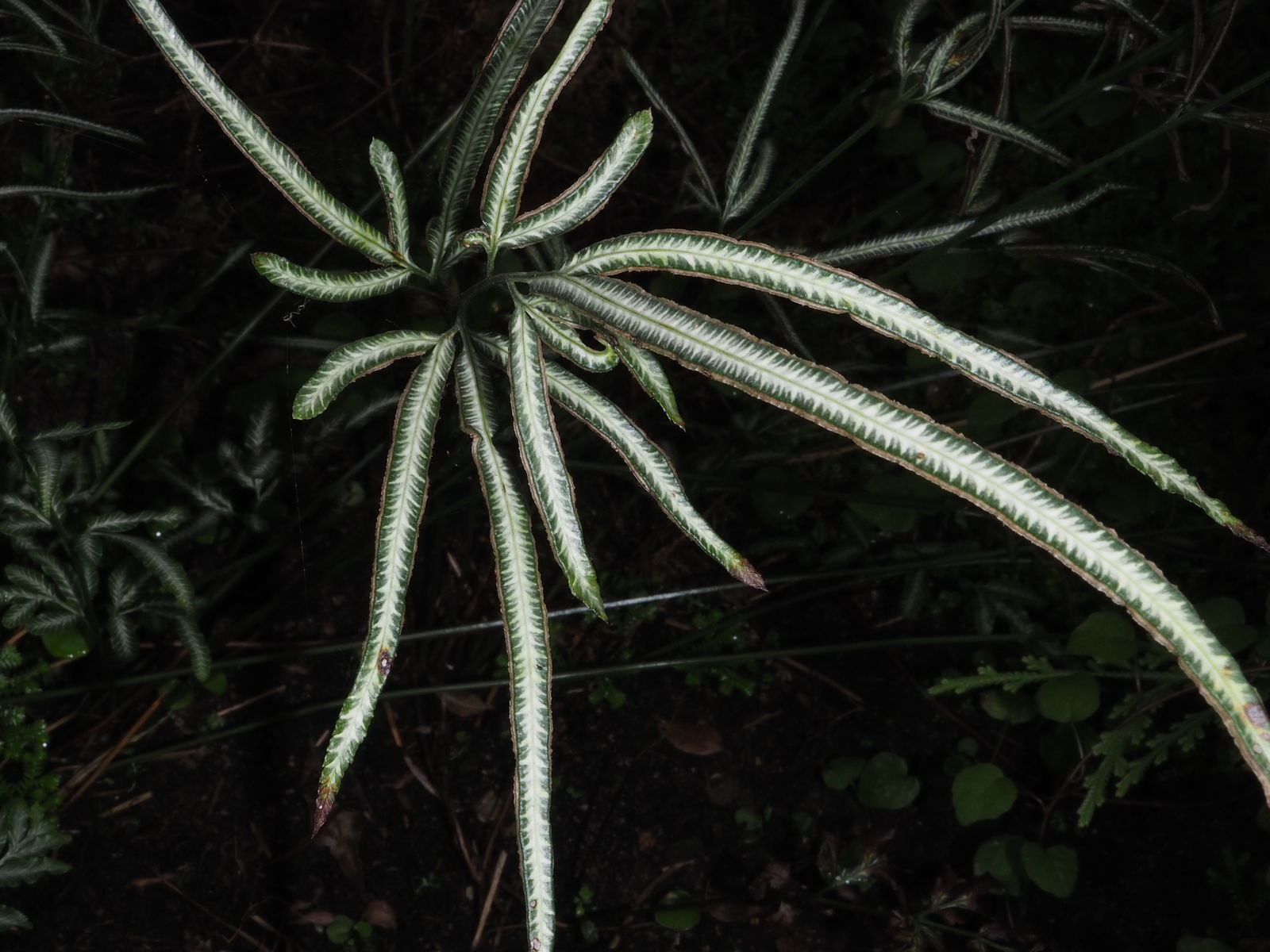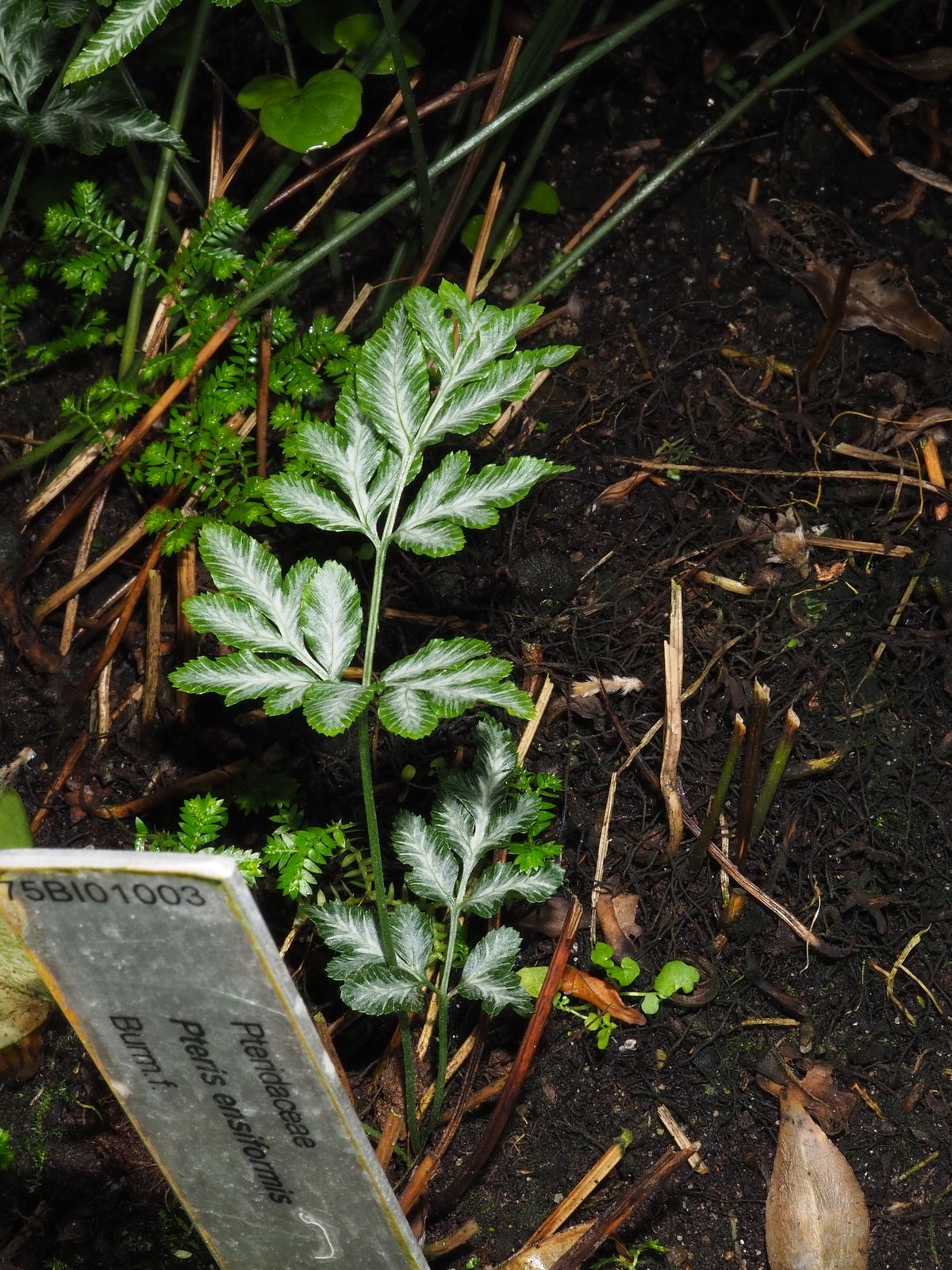Wedgeleaf Pteris, Evergreen Brake
pteris ensiformis
Also known as: ["Slender Brake","Wedgeleaf Fern"]
Overview
A delicate, evergreen fern with wedge-shaped leaves, native to tropical regions.
Benefits & Perks
["aesthetic foliage","shade tolerant","wildlife attractant (bees, butterflies, birds)"]
Botanical Classification
| Phylum: | Tracheophyta |
| Class: | Polypodiopsida |
| Order: | Pteridales |
| Family: | Pteridaceae |
| Genus: | Pteris |
| Botanical Name: | Pteris ensiformis |
Plant Characteristics
Basic Information
- Category: Leaf Plants
- Suitable Location: indoor pot in a humid room with indirect light
- Suitable For:
- Is Weed: No
- Allergenicity: low
Environmental Needs
- Climate: {"temperatureRange":"15–30°C"}
- Hardiness: {"zones":"9–11"}
- Misting: every 2–3 days to maintain moderate humidity
- Drainage: Fast-draining to prevent waterlogging.
- Soil Type: Well-draining, rich potting mix with organic matter; can include peat, perlite, and sand.
Maintenance Level
- Maintenance Level: moderate
- Toughness Level: moderate
- Pruning Frequency: As needed, typically every 1–2 months or when fronds decline.
- Pruning Intensity: Light to moderate; remove only dead or yellowing fronds unless significant shaping is required.
Care Details
Ideal Sunlight Coverage:
Bright indirect light for 6–8 hours daily; avoid direct sunlight which can scorch leaves.
Sunlight Tolerance Tips:
Acclimate to brighter light gradually; place in a spot with filtered light; move to a shadier location during intense summer sun.
Care Requirements
Care Difficulty
easymoderate
Sunlight
partial shade to bright indirect light
Rotate plant weekly for even growth; use sheer curtains to filter direct light; avoid south-facing windows in summer.
Watering
every 7–10 days, allowing soil to dry slightly between waterings
Allow soil to dry between waterings; avoid overwatering; ensure good drainage.
Soil
well-draining, peat-based potting mix
pH: Acidic to neutral (pH 5.5–6.5).
Use a mix with good drainage; avoid heavy clay soils; repot if soil becomes compacted.
Temperature
Prefers 65–75°F (18–24°C); tolerates 50–85°F (10–29°C); avoid sudden temperature fluctuations.
Avoid placing near heating/cooling vents; maintain stable temperatures; protect from drafts.
Fertilizing
every 4–6 weeks during active growth (spring and summer)
Dilute fertilizer to prevent burn; fertilize only when actively growing; flush soil occasionally to prevent salt buildup.
Propagation
Methods
Division or spores; division is more common for home growers.
Step-by-Step Propagation Guide
- Divide clumps at root level.
- Plant divisions in new pots.
- Water lightly.
- Maintain humidity.
Best Time: Spring or early summer when the plant is actively growing.
Environment
High humidity (70–90%), warm temperatures (70–75°F), indirect light.
Medium
Standard potting mix with added perlite for drainage; spores require a sterile, moist medium like sphagnum moss.
Hormone
Not necessary for division; optional for spores to encourage germination.
Timeline
Division: immediate establishment; spores: 1–3 months to germinate, 6–12 months to mature.
Tools Needed
Clean knife or shears, pots, soil mix, humidity dome or plastic bag.
Quick Tips
Ensure each division has roots; keep spore flats consistently moist; avoid direct sunlight during propagation.
Pruning & Repotting
Pruning Guide
Method
Snip individual fronds at the base with clean, sharp tools; avoid cutting into healthy growth.
Pruning Plan
Remove dead or damaged fronds to maintain appearance and health; occasional shaping to control size.
Tools
Clean scissors or pruning shears, disinfectant.
Checklist
Identify dead/damaged fronds; sterilize tools; prune carefully; dispose of clippings.
Repotting Guide
Best Season
Spring, before the active growing season begins.
Pot Size
One size larger pot (e.g., +2 inches in diameter); ensure good drainage.
Method
Remove plant gently; trim roots if necessary; place in a new pot with fresh soil; water lightly.
Suggestions
Repot every 2–3 years or when roots fill the pot; beneficial for growth and soil refresh.
Checklist
Check root bound status; prepare new pot with drainage; trim roots if needed; use fresh soil.
Advanced Care Tips
Watering Mastery
Watering Checklist
Check soil moisture; water thoroughly; ensure drainage; adjust for season.
How to Apply Water Properly
Water deeply until it drains from the bottom, ensuring even moisture without waterlogging; water early in the day to allow foliage to dry.
Watering Schedule Tips
Water thoroughly when the top inch of soil is dry; reduce frequency in winter to prevent root rot.
Soil Improvement
Add perlite or sand for drainage; incorporate compost for fertility; ensure aeration with chunky ingredients.
Temperature Stress Management
Signs of Temperature Issues
Yellowing leaves, stunted growth, or browning leaf tips.
Cold Stress
Slows growth, causes leaf discoloration, and may lead to root damage in prolonged cold.
Solution: Move to a warmer location; insulate pots; avoid placing near drafty windows or doors.
Hot Stress
Wilting, leaf scorch, or drying out due to excessive heat and dry air.
Solution: Increase humidity with misting or a pebble tray; provide shade; ensure adequate watering.
Fertilizing Guide
Fertilizing Checklist
Check growth phase; dilute fertilizer; apply to moist soil; avoid winter feeding.
Fertilizing Method
Use a balanced liquid fertilizer diluted to half strength every 4–6 weeks during growing season (spring/summer); avoid fertilizing in fall/winter.
Common Problems & Solutions
Toxicity Warning
Cats
Slightly ToxicCats may experience mild gastrointestinal upset if they ingest Pteris ensiformis. The insoluble calcium oxalates can cause irritation, but severe toxicity is rare.
⚠️ Symptoms:
🌿 Toxic Parts:
⚡ Toxic If:
if eaten
Dogs
Slightly ToxicIn dogs, ingestion of Pteris ensiformis can lead to mild to moderate gastrointestinal distress due to the presence of insoluble calcium oxalates. The plant is not considered highly toxic but can cause discomfort.
⚠️ Symptoms:
🌿 Toxic Parts:
⚡ Toxic If:
if eaten
Humans
Slightly ToxicPteris ensiformis contains insoluble calcium oxalates, which can cause irritation and inflammation upon ingestion. The plant's effects are primarily localized to the oral cavity and gastrointestinal tract, with minimal systemic toxicity.
⚠️ Symptoms:
🌿 Toxic Parts:
⚡ Toxic If:
if eaten
Frequently Asked Questions
Q: How often should I water Pteris ensiformis?
A: Water when the top inch of soil feels dry, ensuring the pot has good drainage to prevent root rot.
Q: Does Pteris ensiformis need direct sunlight?
A: No, it thrives in indirect, dappled light or partial shade.
Q: Is Pteris ensiformis toxic to pets?
A: No, it is non-toxic to dogs and cats.
Quick Reference
| Family: | Pteridaceae |
| Care: | easy |
| Light: | partial shade to bright indire |
| Water: | every 7–10 days, allowing so |
Get Expert Care Tips
Download the Plantious app for personalized care reminders and plant identification!
Google Play App Store








